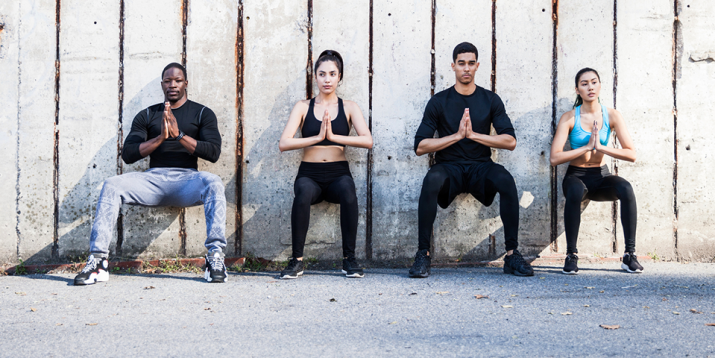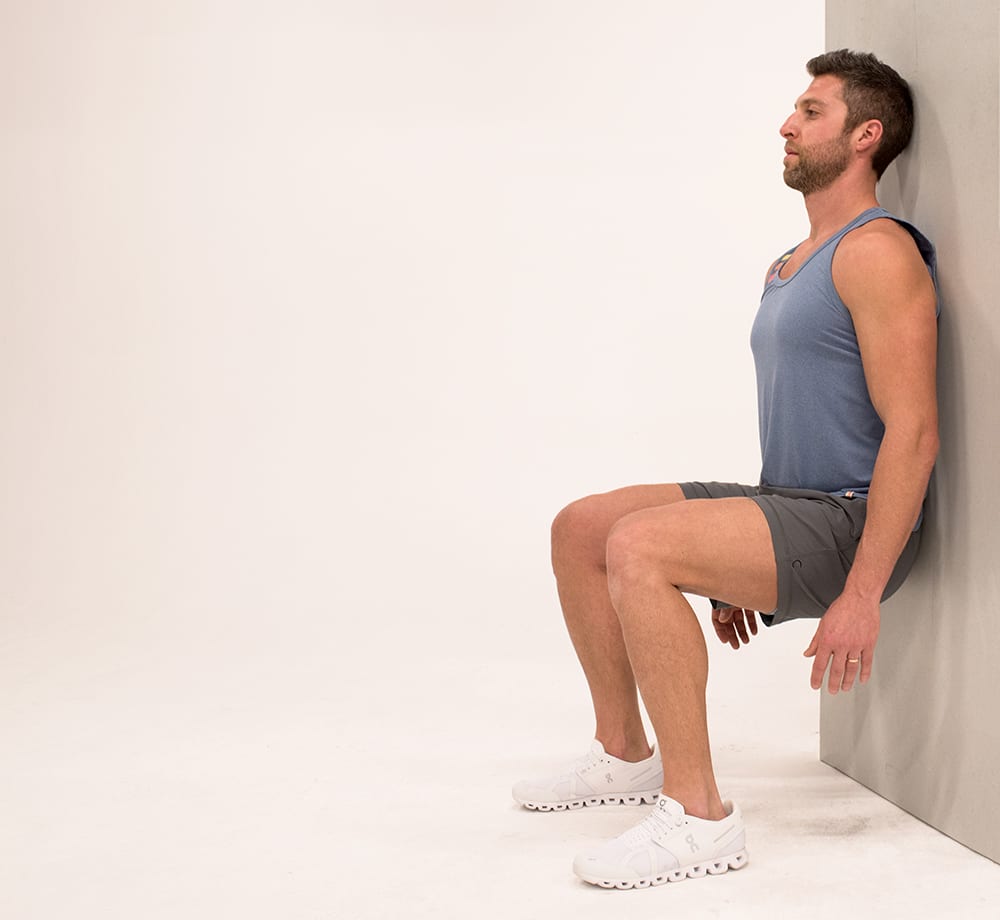How to Do a Wall Sit the Right Way

Most of us have done a wall sit at some point in our lives. (Does high-school gym class ring a bell?)
You put your back against a wall, sit down, and then try to stay there.
And while you almost certainly know the isometric exercise can make your legs quake, you may not know the full potential of the wall sit exercise — or how to get the most out of every “hold-it-right-there” second.
Let’s break it down.
Wall Sit Exercise: Step-by-Step Instructions

First, set a timer. If you’re new to wall sits, try to hold for 30 seconds to a minute. If you’re a pro at them, set a stopwatch instead, and try to one-up yourself each time.
- Stand with your back against a wall and your feet about 18 inches in front of you, spread between hip- and shoulder-width apart.
- Brace your core and grip the floor with your feet.
- Slowly bend at the hips and knees to lower your back against the wall until you are as low as comfortably possible or your thighs are parallel with the floor. Make sure your knees are directly over your ankles with your shins completely vertical.
- Keeping your back against the wall, core braced, and spine neutral, focus on pushing your feet forcefully into the floor. Fully engage your outer thighs and hips by pretending that you’re trying to spread the floor between your two feet. (Neither of your feet will move, but you should feel them working.)
- Hold for the intended amount of time, then step your feet back toward the wall to stand up.
When performing any exercise, form matters. Unfortunately, when it comes to the wall sit exercise, it’s the thing most of us miss.
A properly executed and fully beneficial wall sit exercise isn’t about just sitting down, chilling, and waiting for the clock to run out.
It’s about engaging all of the muscles through your lower body, and even your core and back, to produce the greatest levels of muscle tension and strength, explains Justin Kompf, CSCS, a Boston-based strength coach.
Benefits of Wall Sits
The wall sit is a fantastic isometric exercise. Rather than requiring you to move up and down or side to side, this type of move involves assuming a position and holding it.
As the term implies, you use isometric contraction. Your muscles exert force continually to brace rather than move the joints, says Kompf.
In the case of the wall sit exercise, those muscles are the quadriceps, glutes, and hamstrings.
The joints are the knees and hips, he says. (You might notice that these are the same muscles and joints you work in squats and squat variations, lunges, and step-ups.)
So what are the benefits of performing the wall sit exercise over any other sit-down-and-stand-back-up exercise?
- Knee-friendliness: For anyone with cranky joints or existing knee issues, wall sits are often a comfortable option for strengthening the knees without aggravating them, Kompf says. This is because the knee joints stay stationary, and because your hips are back, with shins vertical, decreasing stress on the knees.
- Quad isolation: The wall sit exercise certainly involves the glutes and hamstrings. But, it also focuses on the quadriceps, in the front of the thighs, to a higher degree than many compound leg exercises, he notes. Again, for anyone who wants to strengthen the muscles surrounding the knee joint to help ease or prevent knee pain, regular wall sits can be beneficial.
Can You Do Wall Sits Every Day?

Do you sit every day? Then you can do wall sits every day!
After all, wall sits are all about strengthening the functional movement patterns of the lower body. That’s a skill we always require.
That said, you don’t have to do wall sits seven days per week.
The frequency with which you should perform them depends on the intensity and duration of your wall sit workouts and, more generally, your lower-body workouts.
For example, performing a single 30- or 60-second wall sit every day can be a great way to build consistency.
However, if you perform multiple max-effort sets of wall sits on Monday, and perform them in tandem with other lower-body exercises like squats, lunges, and deadlifts, your leg muscles will likely need some rest and recovery on Tuesday — and maybe even Wednesday.
Remember, the harder you work, the greater your need for recovery.
Modifications or Alternate Exercises for the Wall Sit
- Go high or low. Want to modify or intensity your wall sit? Simple. Sit higher to make it easier or lower to make it harder.
- Change it up! Although the wall sit exercise will feel “heavier” the lower you sit, doing it at varying depths trains your muscles through a fuller range of motion.
- Weigh yourself down. You can also up the strength factor by adding weight. Holding a dumbbell, kettlebell, or even a loaded backpack in front of your chest will require you to produce extra force through your core and legs, Kompf explains.
- Try kick-outs. While holding a wall sit, raise one foot and then the other from the floor. This will effectively double the workload of the supporting leg.
- Be more dynamic. Integrate dynamic movements into static wall sits. Try squeezing a medicine ball or pillow between your knees to increase recruitment through the adductor muscles of the inner thighs. Hold a weight in front of you with your arms outstretched to tap your core strength.
- Add upper-body work. Integrate biceps curls, band pull-aparts, and shoulder raises during your wall sits to add an upper-body component.
